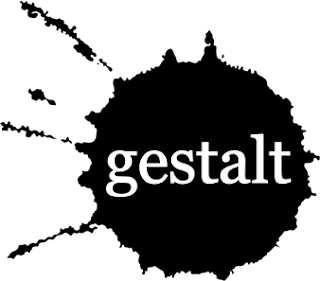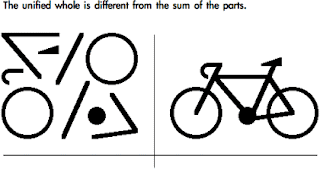Q.2: Name three laws of Gestalt Theory and provide examples to illustrate
your point.
According to Lester, (2006, p.51) “The
word gestalt comes from the German noun that means form or shapes.” Gestalt is
known with the statement of “the whole is different from the sum of its parts.”
(Bourne, Dominski & Loftus, p.22).
This statement means that people organize a structure as a whole and not
from its parts. As an example, the figure shown below:
 |
| Figure 1 |
In figure 1, it shows that people can still see the letter “I” which is
missing in the word. This is because people read the word as a whole and not
one by one according to the alphabets. According to Solso (1995, p.121), “Gestalt
psychologists proposed the perception of visual patterns to be organized
according to the principles of proximity, similarity, and spontaneous
organization.”
There are five laws of gestalt theory, which are, the law of similarity,
law of proximity, law of continuity, the law of common fate and the law of figure
ground or pragnanz and the law of closure. However, only three of these
principles will be explained in this post, which is the law of similarity, the
law of proximity and the law of closure. In addition, the examples for the
principles of gestalt will be provided according to each law.
The first law of gestalt is the law of similarity. According to
Haberlandt, (1997, p.108), “we group stimuli that are close or similar to each
other.” It means that people tend to view things according to their similarity.
For example, in the figure below:
 |
| Figure 2 |
In figure 2, it shows that the squares and circles are grouped according
to the similarity of the shapes. Another example for similarity is shown in the
figure below:
 |
| Figure 3 |
In figure 3, the image shows that the black and white squares are grouped according to
their similarity.
The second law of gestalt is the law of proximity. This law of proximity
is when people tend to perceive things as a group rather than the separated
parts. In figure 4 below, it shows that the dots are actually the same in
number when people count them but some people will think that the separated dots
are lesser than the grouped dots. This shows that people perceived the dots which
are closer and which are formed as a whole and the dots which are farther apart
from each other are seen as unrelated together.
 |
| Figure 4 |
Another example for the law of proximity is the image shown in figure 5
below:
 |
| Figure 5 |
In figure 5 above, when people view the image as a whole, they can see
the image of a tree. However, if a person perceives the image above as a
separated group, it shows that there is an image of a person who is putting
their hands up which are grouped together to form an image of a tree.
The third law is the law of closure. According to Solso, (1995, p.92), “Some
patterns of stimuli seem to be classified the same way by many people.” People
tend to complete the objects which are incomplete. For example, in figure 6:
 |
| Figure 6 |
In figure 6, it shows dots which looks as a partially complete circle. In
addition, it shows that the human’s brain is able to fill in the missing information
to make it as a complete circle. Another example of closure is shown in the
figure below:
In figure 7, it shows the image of a giraffe. This is because, the human
brain can easily see the image of a giraffe due to the areas which are nearly
complete, or there are units which can be seen as close together.
In conclusion, for gestalt theory, any objects, shapes and thing are
grouped together and are seen as a whole. The law of similarity tends to explain that objects, shapes or things are be grouped together according to their likeness and similarities. Whereas, the law of proximity, according to Cassells & Green, (1991, p.15), is the "elements of a stimulus will be perceived as belonging together if they appear to be close together." Moreover, in the law of closure, objects, things or shapes can be simply perceived automatically by the brain because of its closeness. The Gestalt psychologists, such as Koffka and Kohler state that "the whole is greater than the sum of its parts." (Cassells & Green, 1991, p.14)
References
Bourne,
Lyle, E., Dominski, L., Roger, & Loftus, F., Elizabeth, (1979), Cognitive Processes, p.22, Prentice- Hall Inc.
Englewood Cliffs, USA
Cassells, A., & Green, P., (1991), Cognitive Processes: Perception, p.14-16, The British Psychological Society, St. Andrews House, UK
Cassells, A., & Green, P., (1991), Cognitive Processes: Perception, p.14-16, The British Psychological Society, St. Andrews House, UK
Haberlandt,
K., (2nd ed.)., (1997), Cognitive
Psychology, p.108, A Viacom Company, USA
Lester,
P.M., (4th ed.)., (2006), Visual Communication: Images with messages, p.51, Cencage Learning, USA
Solso,
Robert L., (4th ed.)., (1995), Cognitive
Psychology, p.92-121, A Simon & Schuster Company, USA





Well done! This is a very well written piece and you have used excellent resources and research to validate your work. There are also very good examples to exemplify your thoughts.
ReplyDeleteOverall, well done. I am proud of your efforts.